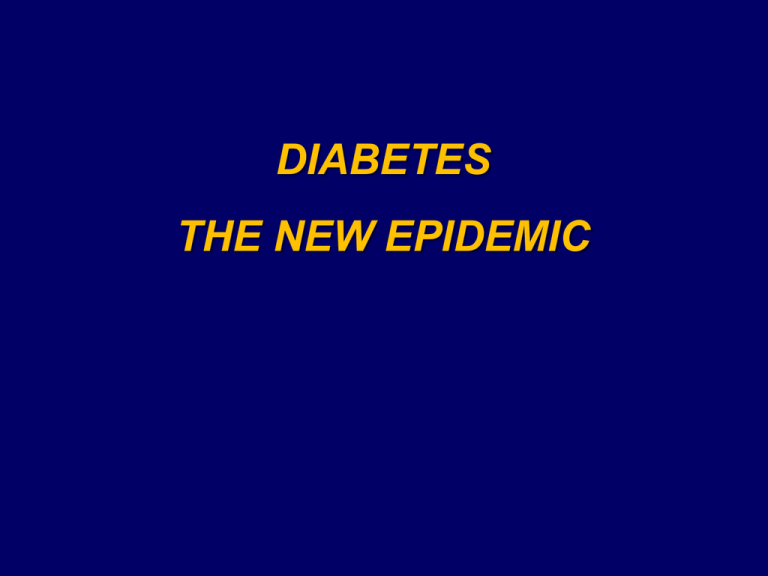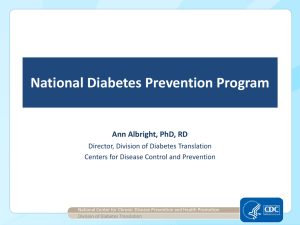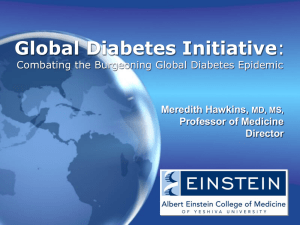
DIABETES
THE NEW EPIDEMIC
Number of people with diabetes
(20-79 years), 2013
Tot: 382,000,000 in 2013
Tot: 471,000,000 in 2035
IDF Diabetes Atlas, 6th Edition, 2013
Trends in age-standardized diabetes prevalence by
regions in MALES (1980-2008)
High income regions Central/Eastern Europe
20 Europe/North America
Sub-Saharan Africa
Oceania
16
Diabetes Prevalence (%)
12
8
4
Central Asia, North
20 Africa, Middle-East
South Asia
East Asia and SE Asia
World
16
12
8
4
1985 1995
Southern America
20
16
Central/Andean
America
2005
High income Asia
12
8
4
1985 1995
2005
1985 1995
2005
1985 1995
2005
Danaei et al.
Lancet 2011
Trends in age-standardized diabetes prevalence by
regions in FEMALES (1980-2008)
High income regions Central/Eastern Europe
20 Europe/North America
Sub-Saharan Africa
Oceania
16
Diabetes Prevalence (%)
12
8
4
Central Asia, North
20 Africa, Middle-East
South Asia
East Asia and SE Asia
World
16
12
8
4
1985 1995
Southern America
20
16
Central/Andean
America
2005
High income Asia
12
8
4
1985 1995
2005
1985 1995
2005
1985 1995
2005
Danaei et al.
Lancet 2011
Increased prevalence of diabetes in
children and adolescents
Results from prescription data from a UK general practice database
Overall prevalence of antidiabetic drug use in children and adolescents by age on IMS,
1998-2005 inclusive girls
boys
and overall
Hsia Y et al., British Journal of Clinical Pharmacology, 2008
Increasing use of antidiabetic drugs among
children and adolescents
*
*
*
Prevalence of insulin, oral antidiabetic and oral antidiabetic drugs with a diabetes indication amongst
children and adolescents aged 0-18 (with 95% CIs), insulin
oral antidiabetic drugs with diabetes indication
oral antidiabetic drugs
; *a significant trend for increasing use (p< 0.001).
Hsia Y et al., British Journal of Clinical Pharmacology, 2008
Type 1 diabetes (15%)
It is caused by an autoimmune reaction, where the
body’s defence system attacks the insulinproducing beta cells in the pancreas. The body can
no longer produce the insulin that it needs.
Type 2 diabetes (85%)
It is the most common type of diabetes. It usually
occurs in adults, but it is increasingly seen in
children and adolescents. The body is able to
produce insulin but either this is not sufficient or the
body is unable to respond to its effects.
Projections of the number of individuals aged <20 years
with type 1 diabetes –2010 to 2050 in the US population
2010
TOT = 179,388
A global increase of 23%
2050
TOT = 587,488
Imperatore et al. Diabetes Care 2012
Projections of the number of individuals aged <20 years
with type 2 diabetes –2010 to 2050 in the US population
2010
TOT = 22,820
A global increase of 49%
2050
TOT = 84,131
Imperatore et al. Diabetes Care 2012
Prevalence of type 2 diabetes in urban and rural
areas in the Arabic-speaking countries, 2011
Badran M and Laher I, International Journal of Endocrinology, 2012
Type 2 diabetes prevalence in South Africa, 2009
Betram MY et al., Global Health Action 2013
Prevalence of type 2 diabetes in Asian countries in 2013
data source: http://www.idf.org/diabetesatlas/data-visualisations
Abdullah N et al., International Journal of Endocrinology, 2014
Worldwide prevalence of obesity
Source: World Health Organization (WHO), 2012
Obesity prevalence is high in developing countries
Prevalence of obesity in Arabian countries in adult males and females
aged between 15 and 100 years, WHO estimates, 2010.
Badran M et al., Journal of Obesity, 2011
Obesity prevalence in adults (Italy), 2011
Trentino
7.5%
Lombardia
Valle d’Aosta 8.9%
8,3%
Piemonte
9.1%
Friuli-V.G.
11.8%
Veneto
9.9% E.Romagna
12.0%
Marche
9.6%
Abruzzo
8.7%
Liguria
8.3%
Toscana
8.7%
Umbria
11.2%
Lazio
9.2%
Campania
10.9%
Sardegna
10.2%
Molise
13.5%
Puglia
12.6%
Basilicata
Calabria
13.1%
11.4%
Sicilia
9.8%
Source: ISTAT 2013
Percentage of US adults who were obese
or diagnosed with diabetes
Obesity (BMI 30 KG/m2)
Diabetes
Centre for Disease Control and Prevention: National Diabetes Surveillance System
http://apps.nccf.cdc.gov/DDTSTRS/default.aspx. Accessed March 2013
Obesity prevalence remains high altough no
significant changes between 2003-2012
9120 participants in the 2011-2012 nationally representative
National Health and Nutrition Examination Survey
Childhood obesity (2-19 years)
Adult obesity (>20 years)
Ogden et al. JAMA 2014
the prevention window
Natural history of type 2 diabetes
Progression of disease
Insulin resistance
Hepatic glucose
production
Insulin level
β-cell function
4–7 years
Post-prandial
glucose
Fasting glucose
Impaired Glucose Tolerance
Frank Diabetes
Diabetes Diagnosis
Relative Risk (95% CI)
Combined impaired fasting glucose (IFG) +
impaired glucose tolerance (IGT) confers the
highest risk of diabetes progression
Isolated
IGT
Isolated
IFG
Metanalysis of total risk of pre-diabetes and diabetes progression,
based on 21 cohort studies and 9 RCT
(follow-up: 1-17 years)
Gerstein HC et al. Diabetes Research and Clinical Practice 2007
Prediabetes increases the risk for
cardiovascular events and death
Relative risk of death is linear by 2h-PG – DECODE study
DECODE study group. Lancet 1999
Pathophysiological defects
in type 2 diabetes
β-Cell
dysfunction
Insulin
resistance
Increased glucose
production by liver
Kahn CR et al. Joslin’s Diabetes Mellitus. 14th ed. Lippincott Williams & Wilkins; 2005
Loss of first phase insulin secretion
in type 2 diabetes
Insulin secretion
(pmol/min)
800
600
normal
400
Type 2
diabetes
200
breakfast
0
6.00
10.00
lunch
14.00
dinner
18.00
22.00
2.00
6.00
time
Polonsky KS et al. N Engl J Med, 1988
-cell mass: decline over diabetes
continuum
The United Kingdom Prospective Diabetes Study (UKPDS)
2
80
60
1
40
20
P < 0.0001
Insulin resistance
Beta cell function (%)
100
0
0
–10 –9 –8 –7 –6 –5 –4 –3 –2 –1
Timing to diagnosis (years)
1
2
3
4
5
6
-cell function
Insulin resistance
HOMA model, diet-treated n = 376
Holman RR et al. Diabetes Res Clin Pract 1998
-cell mass is already impaired at the
diagnosis of type 2 diabetes
3
-cell mass
(%)
2,5
-50%
2
1,5
-63%
1
0,5
0
NGT
IFG
Obese
Type 2
Diabete
diabetes
tipo 2
NGT
Type 2
Diabete
diabetes
tipo 2
LADA
Lean
Butler AE et al. Diabetes 2003; Leslie RD e Pozzilli P, J Clin Endocrinol Metab 2006
Oral hypoglycemic agents targeting the
pathophysiologic defects in type 2 diabetes
Pancreas
Impaired insulin
secretion
Liver
Sulfonylureas
Meglitinides
DPP-4 inhibitors
GLP1 analogues
Muscle
and fat
↓Glucose level
Hepatic glucose
overproduction
Insulin
resistance
Gut
Metformin
TZDs
DPP-4 inhibitors
GLP1 analogues
TZDs
Metformin
α-Glucosidase inhibitors
Metformin
Glucose
absorption
Lifestyle intervention can prevent
type 2 diabetes development
Trial
Da
Qing
6
1. Diet
2. Exercise
3. Diet & Exercise
RR
(95% CI)
0.66 (0.53-0.81)
0.56 (0.44-0.70)
0.49 (0.33-0.73)
522
IGT
overweight
(Finland)
3.2
Diet & Exercise
0.42 (0.3-0.7)
3,234
IGT
(USA)
2
1. Diet & Exercise
2. Metformin
0.42 (0.34-0.52)
0.69 (0.57-0.83)
2.5
1. Diet & Exercise
2. Metformin
3. Metformin +
Diet & Exercise
0.72 (0.62-0.80)
0.74 (0.65-0.81)
0.72 (0.62-0.80)
n
Population
577
IGT
(China)
DPS
DPP
IDPP
531
IGT
(India)
Follow-up
(years)
Interventions
DPS, Finnish Diabetes Prevention Study; DPP, Diabetes Prevention Program;
IDPP, Indian Diabetes Prevention Program
Incidence of
Diabetes
in the DPP trial
Percent
developing diabetes
All
Placebo (n=1082)
Metformin (n=1073, p<0.001 vs. Placebo)
Lifestyle (n=1079, p<0.001 vs. Met , p<0.001 vs. Plac )
Lifestyle
p<0.001vs.vs.
Metformin ,
Metformin(n=1079,
(n=1073, p<0.001
Plac)
Placebo (n=1082) p<0.001 vs. Placebo)
Cumulative incidence (%)
40
30
participants
Risk reduction
31% by metformin
58% by lifestyle
20
10
0
0
1
2
3
4
Years from randomization
The DPP Research Group, NEJM 346:393-403, 2002
Pharmacological intervention to
prevent type 2 diabetes
Trial
DPP
Subjects
Population
(n)
3,234
Drug
Follow-up
(years)
RR
(95% CI)
Weight
Adverse
events
↓
GI symptoms
IGR
Metformin
overweight (850mg bid)
2.8
0.69
(0.57-0.83)
STOP-NIDDM 1,419
IGT
Acarbose
(100mg tid)
3.9
0.75
(0.63-0.90)
GI symptoms
Voglibose
1,780
IGT
Voglibose
(0.2mg tid)
3
0.59
(0.43-0.81)
GI symptoms
DREAM
5,269
IGR
Rosiglitazone
(8mg/day)
3
0.40
(0.35-0.46)
↑
Edema
ACT-NOW
602
IGT
Pioglitazone
(30-45mg/day)
2.4
0.28
(0.16-0.49)
↑
Edema,
Dyslipidemia
XENDOS
3,277
IGT obese
Orlistat
(120mg tid)
4
0.72
(0.58-0.91)
↓
GI symptoms
ORIGIN
1,456
IGR
Glargine
6
0.80*
(0.64-1.00)
↑
Hypoglycemia
* Odds Ratio; IGR, Impaired glucose regulation; GI, Gastro-intestinal.
The STOP-NIDDM: Acarbose
Acarbose
100 mg TID
n=682
Placebo
n=686
25% Relative Risk
Reduction
P=0.0022
Acarbose reduced
risk of new
• Hypertension
>140/90; 5.3%
absolute risk
reduction (P=0.006)
• Myocardial
infarction (P=0.02)
• Any CVD event:
CHD, CV death or
stroke, CHF, PVD
(P=0.03)
Chiasson JL, et al. Lancet. 2002;359(9323): 2072-2077;
Chiasson JL, et al. JAMA. 2003;290(4):486-494.
ACT NOW: Pioglitazone
• Pioglitazone reduced risk of type 2 diabetes by 72%
vs. placebo (HR 0.28; 95% CI 0.16–0.49 P<0.001)
• Conversion to normal glucose tolerance: 48% of
patients with pioglitazone vs 28% with placebo
(P<0.001)
• Pioglitazone reduced fasting glucose,
2-hour glucose, HbA1c
• Weight gain, edema observed in the pioglitazone arm
DeFronzo RA, et al, for the ACT NOW Study. N Engl J Med. 2011
ORIGIN: Insulin glargine
Gernstein et al. NEJM 2012
Sustained effect of lifestyle
intervention
Diabetes Prevention Study
3-years post-intervention follow-up
Lindstrom J et al. Lancet 2006
DaQing 20-years post-intervention
follow-up study
Li G et al. Lancet 2008
DPP: Metformin had sustained
effect after drug washout
• Brief (1-2 week) drug washout study at end of
Diabetes Prevention Program trial
• After washout, diabetes was more frequently
diagnosed in metformin vs. placebo (1.49; 0.93, 2.38;
P=0.098)
• DPP primary analysis: metformin decreased
diabetes risk by 31%
• Washout: 26% accounted for by pharmacological
effect of metformin
• Postwashout: diabetes reduced by 25%
Diabetes Prevention Program Research Group. Diabetes Care. 2003;26:977-980.
Summary of lifestyle/
pharmacological interventions
Lifestyle intervention continues to have an effect;
most drugs do not
Lifestyle
Study
Intervention
Treatment
Risk Reduction
34% - 69%
Da Qing
IGT
577
Lifestyle
6 years
20 years
Finnish DPS
IGT
523
Lifestyle
3 years
7 years
58%
DPP
IGT
3,324
Lifestyle
3 years
58%
N
Intervention
Treatment
Risk Reduction
Study
Pharmacologic
N
DPP
IGT
3,324
Metformin
3 years
31%
DREAM
IGT
5,269
Rosiglitazone
3 years
60%
STOP-NIDDM
IGT
1,429
Acarbose
3 years
21%
ACT NOW
IGT
~600
Pioglitazone
3 years
81%
ORIGIN
IGR
1,456
Glargine
6 years
20%
Dietary intake keep increasing…
Grains and fats account for nearly all of the increase
in daily calorie consumption since 1970
Daily calorie consumption by food group - US
Added fats
Flour, cereal products
Proteins
2007
1990
1970
Added sugars
Dairy
Vegetables
Fruit
0
100
200
300
400
500
600
700
800
Source: Food and Agriculture Organization of the United Nations
… while price of food, adjusted
for inflation, has dropped
The price of added sugars has dropped significantly
more than the price of healthful foods
Inflation-Adjusted Cost of One Ton of Various Food
-50%
Proteins
+30%
Fruits
-38%
Fats
Vegetables
0%
Dairy
-38%
-29%
Grain
Sugar
-50%
0
500
1,000 1,500 2,000 2,500 3,000 3,500 4,000
Source: USDA's Economic Research Service
2007
1990
1970
Taxing unhealthy food and
drinks to improve health?
Examples of Health-related food taxes
Mytton et al. BMJ 2012
Junk food taxes might reduce energy
intake, weight and insulin levels over time
20 years longitudinal study (CARDIA study) on 5,115 young adults
* and e, P<0.05
Duffey et al. Arch Intern Med 2010
Financial Incentive–Based
Approaches for Weight Loss
57 healthy subject 30-70 years, BMI 30-40,
were randomized to 3 weight loss
plans:
1) Monthly weigh-ins,
2) LOTTERY incentive program:
participants played a lottery and
received the earnings if they achieved
or lost more than the target weight
3) DEPOSIT incentive: participants
invested their own money, which they
lost if they failed to achieve weight
goals.
16 weeks follow-up
The use of economic incentives produced significant weight loss (more
than the control group) during the 16 weeks of intervention that was not
fully sustained (Volpp et al. JAMA 2008)
Change in weight from baseline (lb)
Financial incentives for weight loss:
group-based incentives are more effective than
individual incentives
Control group
Individual-incentive group*
Group-incentive group**
Week
105 obese employers (BMI 30-40) randomized to and followed up to 24 weeks:
*INDIVIDUAL INCENTIVE: $100 per person per month for meeting or exceeding
weight-loss goals
**GROUP INCENTIVE: $500 per month split among participants within groups
of 5 who met or exceeded weight-loss goals
CONTROL GROUP
Kullgren et al. Ann Intern Med 2013
Peer mentoring and financial
incentives for blood glucose control
118 African Americans veterans assinged to the following three groups and followedup to 6 months:
1) USUAL CARE
2) PEER MENTOR Patients were assigned a mentor who formerly had poor glycemic
control but now had good control (HbA1c level 7.5%). The mentor was asked to talk
with the patient at least once per week. Peer mentors were matched by race, sex, and
age.
3) FINANCIAL INCENTIVES
- $100 by decreasing HbA1c by 1%
- $200 by decreasing HbA2c by 2% or to an HbA1c 6.5%.
Peer mentorship improved glucose control in a cohort of African American
veterans with diabetes. (Long et al. Annals of Int Med 2012)
Call for Action
• We must identify patients at highest risk
(prediabetes)
• Modest lifestyle changes are most effective
• Sustain interventions
• Increase opportunities for community programs to
support prevention
• Delaying or preventing type 2 diabetes is costeffective and will help turn the tide on the diabetes
epidemic
• “Health-taxes” for improving adherence to healthy
lifestyle or reducing calorie intake might be
considered
A possible approach to tackle
the diabetes epidemic
Low Adherence
Lifestyle
intervention
Detect and tackle barriers
Good Adherence
Easy to deliver
Sustained effect
Low cost
Junk
food
taxes
Normal blood glucose
“BMI taxes”
or
“BMI prize”
“Blood glucose taxes”
or
“Blood glucose prize”
Obesity
Pre-diabetes
Lifestyle
Genetic background
Diabetes








